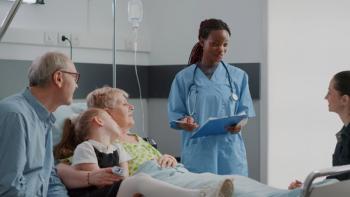
Health Insurance Tax in 2018 Impacted National Healthcare Spending, Report Says
The analysis estimates that in 2018, healthcare spending grew at a rate of 4.6% to $3.6 trillion, or $11,172 per person, faster than 2017’s 4.2% but equal to the 2016 rate.
The reinstatement of the health insurance tax (HIT) in 2018 was a driving factor in the increase of US healthcare spending that year, which otherwise was fairly stable, according to a report released Thursday by the Office of the Actuary at CMS.
In addition, for the second year in a row, the number of uninsured people increased by 1.0 million, reaching 30.7 million in 2018.
The tax was suspended by Congress is 2017 and 2019 but is set to resume January 1, 2020, unless Congress decides to suspend or end it. The tax was instituted as part of the Affordable Care Act.
The analysis, published by
The net cost of health insurance rose 13.2% following growth of 4.3% in 2017, driven primarily by the HIT. The growth rate for total personal healthcare spending—expenditures for goods and services—remained the same in 2017 and 2018, at 4.1%.
“Health care spending growth picked up across all major payers in 2018 as medical prices grew faster, due in part to the reinstatement of the health insurance tax on all health insurance providers,” said Micah Hartman, a statistician in the CMS Office of the Actuary and first author of the Health Affairs article, in a statement. “However, economic growth outpaced health care spending and the share of the economy devoted to health care fell.”
The 0.4-percentage-point acceleration uptick was also driven by faster growth in private health insurance and Medicare.
On a per capita basis, national health spending grew 4% in 2018, compared with growth of 3.5% in 2017. Faster growth in medical prices more than offset slower growth in the use and intensity of healthcare goods and services.
Medical price growth increased 2.1% in 2018, compared with 1.3% in 2017, while the residual use and intensity of services increased 1.3% in 2018, slower than 1.6% growth in 2017. The rate of growth due to changes in the age and sex mix of the population remained at 0.6% in 2018.
Private health insurance reached $1.2 trillion in 2018 and accounted for 34% of total national health spending, rising 5.8%, faster than the 4.9% growth in 2017.
Enrollment in private health insurance decreased 0.8% in 2018 primarily because of declines in nonmarketplace directly purchased and employer-sponsored insurance plans. On a per-enrollee basis, private health insurance spending increased 6.7% over 2017—the highest growth rate since 7.5% in 2004—which can be attributed primarily to the net cost of private insurance.
Medicare spending reached $750.2 billion in 2018, accounting for 21% of total healthcare expenditures. Total Medicare spending increased 6.4%, following slower growth of 42% in 2017. Total Medicare enrollment growth was steady, but per-enrollee Medicare expenditures grew more rapidly, increasing 3.7% in 2018 compared with 1.6% in 2017. Fee-for-service Medicare spending accounted for 64% of overall Medicare spending in 2018, down slightly from a 66% share in 2017. Spending on Medicare Advantage accounted for 36% of total Medicare spending in 2018 and increased 11.8%, up from 9.9% growth in 2017.
Medicaid spending rose 3% to $597.4 billion, accounting for 16% of total national health expenditures, following growth of 2.6% in 2017. 2018 was influenced by faster growth in the net cost of insurance and was partially offset by a deceleration in enrollment growth and slower spending growth for Medicaid managed care goods and services. On a per-enrollee basis, Medicaid spending increased 2% compared with 1.2% growth in 2017.
By major goods and services:
- Hospital spending rose 4.5% to $1.2 trillion in 2018, representing 33% of overall spending. Growth in expenditures for hospital care increased at about the same rate in both 2017 and 2018 (4.7% and 4.5%, respectively). Hospital prices increased 2.4% in 2018, compared to 1.7% the year prior, while use and intensity of goods and services grew more slowly in 2018. Growth in total inpatient days was slower in 2018 at 0.7%, compared with 1.7% in 2017.
- Physician and clinical services spending increased 4.1% in 2018, slower than the growth rate of 4.7% in 2017, with total physician and clinical services expenditures reaching $725.6 billion in 2018, or 20% of overall health care spending. Spending growth for clinical services (6.0%) continued to outpace growth in spending for physician services (3.6%) in 2018.
- Retail prescription drugs spending reached $335.0 billion in 2018 and represented 9% of overall health spending. Total retail prescription drug spending accelerated from 1.4% growth in 2017 to 2.5% last year, spurred by an increase in the use and mix of drugs consumed. Retail prescription drug prices fell 1% in 2018 due to a decline in generic drug prices as well as slower and relatively low growth in prices for brand-name drugs.
Reference
Hartman M, Martin AB, Benson J, Catlin A. National health care spending in 2018: Growth driven by accelerations in Medicare and private insurance spending. Health Aff (Millwood). 2020; (39)1. doi: 10.1377/hlthaff.2019.01451.
Newsletter
Stay ahead of policy, cost, and value—subscribe to AJMC for expert insights at the intersection of clinical care and health economics.














































